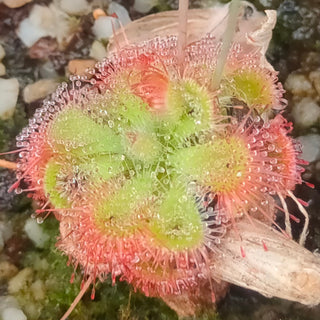Actinidia arguta
HARDY KIWI
- Unit price
- / per
Actinidia arguta goes by common names hardy kiwifruit, kiwi berry, arctic kiwi, baby kiwi, dessert kiwi, grape kiwi, northern kiwi, or cocktail kiwi, and are edible, similar to kiwifruit in taste and appearance, but are green, brownish, or purple with smooth skin, sometimes with a red blush. Often sweeter than the kiwifruit, hardy kiwifruit can be eaten whole and do not need to be peeled.
The fast-growing, climbing is very hardy (hence the name hardy kiwi), and is capable of surviving slow temperature drops to -34 C (-30 F. The plants need a frost-free growing season of about 150 days, and are not damaged by late freezes. Indeed, a period of winter chill is necessary for successful cultivation.
In domestic cultivation, a trellis may be used to encourage horizontal growth for easy maintenance and harvesting; however, the plants grow extremely quickly and require a strong trellis for support. Each can grow up to 20 ft in a single season, given ideal growing conditions. For commercial planting, placement is important: plants can tolerate partial but yields are optimized with full sunlight.
Hardy Kiwi is native to Japan, Korea, Northern China, and Russian Siberia, and is grown around the world.
Type: Hardy vine
Hardiness zones: 5-11
Location: Sun or part sun
Seeds per packet: 10
Soak the seeds for 12-24 hours before planting. Sow just under the surface of the soil and water in. Then cover them with plastic and place in a fridge for 90 days. Be sure they stay moist. After the cold stratification period they are then brought back to room temperature 20-22C (68-72F) for them to germinate. Germination is generally 30-90 days after the warming period, though some can take longer. Do not discard the planting tray, as patience is needed, and they are well worth the wait.
Actinidia arguta
HARDY KIWI
- Unit price
- / per
Multiple secure payment options available.
Adding product to your cart
You may also like
Actinidia arguta goes by common names hardy kiwifruit, kiwi berry, arctic kiwi, baby kiwi, dessert kiwi, grape kiwi, northern kiwi, or cocktail kiwi, and are edible, similar to kiwifruit in taste and appearance, but are green, brownish, or purple with smooth skin, sometimes with a red blush. Often sweeter than the kiwifruit, hardy kiwifruit can be eaten whole and do not need to be peeled.
The fast-growing, climbing is very hardy (hence the name hardy kiwi), and is capable of surviving slow temperature drops to -34 C (-30 F. The plants need a frost-free growing season of about 150 days, and are not damaged by late freezes. Indeed, a period of winter chill is necessary for successful cultivation.
In domestic cultivation, a trellis may be used to encourage horizontal growth for easy maintenance and harvesting; however, the plants grow extremely quickly and require a strong trellis for support. Each can grow up to 20 ft in a single season, given ideal growing conditions. For commercial planting, placement is important: plants can tolerate partial but yields are optimized with full sunlight.
Hardy Kiwi is native to Japan, Korea, Northern China, and Russian Siberia, and is grown around the world.
Type: Hardy vine
Hardiness zones: 5-11
Location: Sun or part sun
Seeds per packet: 10
Soak the seeds for 12-24 hours before planting. Sow just under the surface of the soil and water in. Then cover them with plastic and place in a fridge for 90 days. Be sure they stay moist. After the cold stratification period they are then brought back to room temperature 20-22C (68-72F) for them to germinate. Germination is generally 30-90 days after the warming period, though some can take longer. Do not discard the planting tray, as patience is needed, and they are well worth the wait.




































